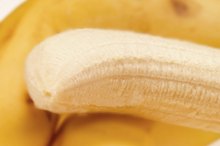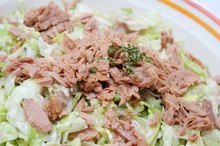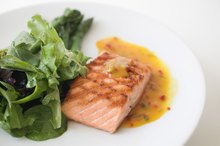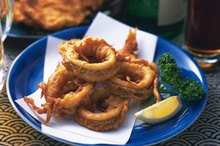What does fact checked mean?
At Healthfully, we strive to deliver objective content that is accurate and up-to-date. Our team periodically reviews articles in order to ensure content quality. The sources cited below consist of evidence from peer-reviewed journals, prominent medical organizations, academic associations, and government data.
The information contained on this site is for informational purposes only, and should not be used as a substitute for the advice of a professional health care provider. Please check with the appropriate physician regarding health questions and concerns. Although we strive to deliver accurate and up-to-date information, no guarantee to that effect is made.
Canned Tuna & Potassium
The American Heart Association recommends eating fish at least two times per week for a variety of health benefits. Canned tuna is a great way to fulfill the recommended fish intake as it is low in fat and high in several vitamins and minerals, as well as healthy oils and protein. It provides a minor amount of potassium, an essential mineral and electrolyte.
Potassium Content
In general, fruits and vegetables are the best sources of potassium, but meats and fish can contribute to daily potassium needs as well. A 6-ounce serving of canned light tuna in oil contains 352 milligrams of potassium, or 7.4 percent daily value based on a 2,000-calorie diet, according to the USDA National Nutrient Database 123. A 6-ounce serving of canned white tuna in oil contains the highest amount of potassium, with 566 milligrams, or 12 percent daily value. The same serving size of light tuna tuna canned in water contains 304 milligrams of potassium, or 8.6 percent daily value, while white tuna canned in water contains 403 milligrams of potassium, which is over 10 percent of the daily value.
- In general, fruits and vegetables are the best sources of potassium, but meats and fish can contribute to daily potassium needs as well.
- The same serving size of light tuna tuna canned in water contains 304 milligrams of potassium, or 8.6 percent daily value, while white tuna canned in water contains 403 milligrams of potassium, which is over 10 percent of the daily value.
Dietary Reference Intakes
Foods With Potassium Bicarbonate
Learn More
Potassium is an important mineral for proper functioning of the body. The Institute of Medicine recommends 4,700 milligrams per day for adults, adolescents and pregnant women. Children ages 9 to 13 should consume 4,500 milligrams per day, ages 4 to 8 approximately 3,800 milligrams, and ages 1 to 3 about 3,000 milligrams. Infants needs between 400 and 700 milligrams and women who are lactating need 5,100 milligrams, according to the Institute of Medicine.
- Potassium is an important mineral for proper functioning of the body.
- Infants needs between 400 and 700 milligrams and women who are lactating need 5,100 milligrams, according to the Institute of Medicine.
Function
Potassium functions as a dietary mineral and electrolyte, a substance that conducts electricity in the body that is required for the conduction of nerve impulses and muscle contraction. Potassium is required for normal cellular function as is the primary intracellular cation, or positively charged ion in the body. It plays a large role in balancing the fluids of the body and is vital in maintaining the proper contraction of the heart. According to the Linus Pauling Institute, diets rich in potassium are associated with a decreased risk of stroke, high blood pressure and osteoporosis 6.
- Potassium functions as a dietary mineral and electrolyte, a substance that conducts electricity in the body that is required for the conduction of nerve impulses and muscle contraction.
- Potassium is required for normal cellular function as is the primary intracellular cation, or positively charged ion in the body.
Pairing Tuna With Potassium
How to Use Epsom Salt in a Jet Tub
Learn More
Although tuna doesn't offer a significant amount of potassium, it can easily be paired with foods that do. If you are eating tuna as a salad have it on a bed of greens such as fresh spinach, collard greens or kale. If you are eating tuna on a sandwich, substitute spinach or collard greens for lettuce and be sure to add slices of fresh tomato to the mix, as tomatoes are a good source of potassium according to the UC Davis Health System 8. You could have tomato soup or nuts as a side dish, and have a cup of fresh melon or peaches for dessert.
- Although tuna doesn't offer a significant amount of potassium, it can easily be paired with foods that do.
- If you are eating tuna on a sandwich, substitute spinach or collard greens for lettuce and be sure to add slices of fresh tomato to the mix, as tomatoes are a good source of potassium according to the UC Davis Health System 8.
Related Articles
References
- USDA National Nutrient Database: Fish, Tuna, Light, Canned in Oil
- USDA National Nutrient Database: Fish, Tuna, White, Canned in Oil
- USDA National Nutrient Database: Fish, Tuna, Light, Canned in Water
- USDA National Nutrient Database: Fish, Tuna, White, Canned in Water
- University of Maryland Medical Center: Potassium
- Oregon State University -- Linus Pauling Institute: Potassium
- US Davis Health System: Potassium Foods
- Fish, tuna, light, canned in water, without salt, drained solids. FoodData Central. U.S. Department of Agriculture. Published April 1, 2019.
- Dhurmeea Z, Pethybridge H, Appadoo C, Bodin N. Lipid and fatty acid dynamics in mature female albacore tuna (Thunnus alalunga) in the western Indian Ocean. PLOS ONE. 2018. doi:10.1371/journal.pone.0194558
- Vitamin B12 or folate deficiency anaemia. National Health Service. Updated 2019.
- Sparkes C, Gibson R, Sinclair A, Else PL, Meyer BJ. Effect of low dose docosahexaenoic acid-rich fish oil on plasma lipids and lipoproteins in pre-menopausal women: A dose⁻response randomized placebo-controlled trial. Nutrients. 2018;10(10). 10.3390/nu10101460
- Simonetto M, Infante M, Sacco RL, Rundek T, Della-Morte D. A novel anti-inflammatory role of omega-3 PUFAs in prevention and treatment of atherosclerosis and vascular cognitive impairment and dementia. Nutrients. 2019;11(10). doi:10.3390/nu11102279
- Damanti S, Azzolino D, Roncaglione C, Arosio B, Rossi P, Cesari M. Efficacy of nutritional interventions as stand-alone or synergistic treatments with exercise for the management of sarcopenia. Nutrients. 2019;11(9). doi:10.3390/nu11091991
- Diabetes superfoods. American Diabetes Association. Updated 2020.
- Histamine toxicity. American Academy of Allergy, Asthma & Immunology. Updated 2020.
- ACOG practice advisory: Update on seafood consumption during pregnancy. American College of Obstetricians and Gynecologists. Updated 2017.
- Canned tuna. Seafood Health Facts: Making Smart Choices Balancing the Benefits and Risks of Seafood Consumption. Updated 2020.
- Selecting and serving fresh and frozen seafood safely. U.S. Food and Drug Administration. Updated 2019.
Writer Bio
Jason Dority has been writing health-related articles and developing community resources for healthier lifestyles since 2007. He currently works for the Indiana University School of Medicine's Diabetes Translational Research Center. Dority holds a Master of Science in biology from Indiana University.









